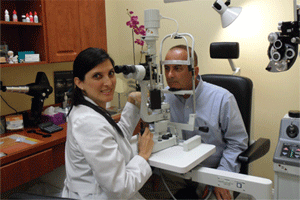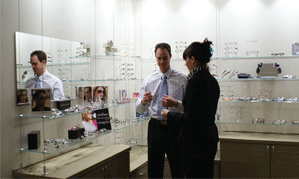Building an optometric practice from the ground up can be the challenge of a lifetime. It means rolling up your sleeves, facing a multitude of personal, professional and financial challenges head on, and spending countless hours making all kinds of decisions.
Despite those challenges, bringing your own vision of patient care to life and taking complete ownership of your earning potential are priceless rewards. As optometrists, many of us have excellent clinical skills but possess limited business knowledge.
Many pitfalls can take a new business owner by surprise. Regardless of how long you’ve been in practice, recognizing and avoiding potentially costly errors is essential to laying a strong foundation for financial success.
In this article, we’ll identify five of the most common errors and offer some suggestions on how to steer clear of them so you can conserve your capital and effectively manage debt.
1. Buying Too Much Too Soon
When setting up shop, it can be tough to resist going on a shopping spree for the latest gadgets, especially with the number of exciting advances in eye care technology over the past decade.
Scanning lasers, for instance, have enhanced our ability to diagnose and treat patients with glaucoma and macular disease. An array of retinal cameras, topographers, visual field analyzers, specular microscopes and hyperacuity perimeters has enhanced the overall delivery of care. Even automated refraction systems have increased our efficiency while improving the patient’s perception of care.

“Great exams can be done with basic equipment, and every year you can invest in more technology,” says Amarella Dalmazzo, O.D., of Miami Gardens, Fla. “This will serve to surprise your established patients with new and improved changes.”
Although any of these options would enhance the patient’s experience, you need to ask yourself some tough questions to determine whether purchasing them is a wise decision. Which (if any) of these expensive devices is needed in my young practice? Based on initial patient volume, what is the cost vs. return and will it justify the expense? Will delaying the purchase of such equipment impact the long-term success of my practice?
To answer these questions, you must realistically estimate the number of patients you will examine each month during the first two years. Because this can be a challenging task, it’s helpful to talk with optometrists who have recently started their own practices to get some experience-based projections. The average number of monthly exams may be surprisingly lower than what your business plan may have projected.
Examining demographics is also part of this equation. Establishing whether your patient base is more at risk for ocular disease, or less so, can help you to decide how soon to bring in this technology. While this assessment may vary by practice location, most optometrists find they don’t typically use these devices often in the early stages of the practice.
You may covet a high-tech scanning laser, but using it two or three times a month amounts to idle technology and a financial liability for your new practice.
Far from discouraging the acquisition of any modern diagnostic technology, it’s reasonable to consider what technology is essential to fulfill your patient care strategy. There’s no shame in starting with less than what you may imagine for your ideal practice. Diagnostic technology can and should be added over time, based on patient volume.
In fact, adding more equipment as the practice progresses may provide a great opportunity to reconnect with your returning patients. “Great exams can be done with basic equipment, and every year you can invest in more technology,” says Amarella Dalmazzo, O.D., of Miami Gardens, Fla. “This will serve to surprise your established patients with new and improved changes.”
If you decide to hold off on the expensive diagnostic equipment, then you need to have a referral plan in place for patients who require those tests. Before you start your practice, determine if there is a referral center or another optometrist in your area who is comfortable performing these tests and willing to send the patient back to your practice for any necessary treatment. Establishing such a relationship allows you to delay expensive equipment purchases until your patient volume grows.
Why the concern for equipment purchases when you can simply borrow enough start-up funds to cover all of this equipment in addition to build-out, inventory and working capital? Strategically you’ll be creating a financial advantage by conserving working capital and minimizing initial debt. Overspending on equipment is probably the biggest draw on start-up capital.
Remember, just because your lender approves a large start-up loan amount does not mean you have to use it all. Prudent spending yields less debt, lower monthly liabilities, and a closer monthly break-even point.
2. Overspending on Frame Inventory
While selling exclusive, high-end frames may seem appealing, it’s not realistic for most start-ups. Practice location and patient demographics definitely factor into how successful this model is for a particular practice, but it typically takes years to establish the patient base to support it. The truth is you won’t know exactly what your patient base will support until you spend time building it.
Spending too much on high-end frame inventory could burn needed working capital and overload your frame board. In addition, many high-end lines require a minimum purchase amount, dictate minimum quarterly or yearly frame purchases to maintain the account, and have inflexible and potentially costly return and exchange policies.
“Consider the return on an alternate purchase or investment,” suggests Chris Woodruff, O.D., of Davie, Fla. Spending too much on frame inventory could keep you from investing in other areas of the practice, which may yield a better return.

“You are what you sell—your services and products are a direct reflection of the reputation that your business will have in the community,” says Brent Segeleon, O.D., of Williamsburg, Va. “The frames you choose to have in your office will directly project your image to your patients.”
Realistic sales projections are also crucial in choosing which frame lines you should introduce in your practice. In the early stages of your practice, you might only be dispensing a dozen or so spectacle prescriptions each month. As the practice grows and you start to develop a better understanding of the frame styles that appeal to your patient base, you can add frame lines accordingly.
“My biggest challenge was initially forecasting my market,” says Neal Pithwa, O.D., of Knoxville, Tenn. “You need data, and that only comes over time with repeated exposure to the market.”
However, it’s also important that you don’t go to the other extreme by investing as little as possible in frame inventory. It may lower your start-up costs, but it could also affect how patients perceive your practice and stunt your revenue growth. When Brent Segeleon, O.D., recently established his private practice in Williamsburg, Va., he took a budgeted approach but was careful not to risk damaging his brand.
“You are what you sell—your services and products are a direct reflection of the reputation that your business will have in the community. The frames you choose to have in your office will directly project your image to your patients,” Dr. Segeleon explains. “Budgeting is prudent, but starting with too many lower-cost items is not.” Rather, attempt to build an initial inventory that is fairly balanced but still budget friendly.
You should also evaluate your vendor relationships. Consider working with vendors who will exchange your inventory without penalty. “Use fewer vendors and have them compete for board space,” Dr. Woodruff advises. This competition may lead to better pricing and help you better serve your evolving patient base.
3. Inefficient Patient Scheduling
Be smart about scheduling. The average start-up practice schedules only a few dozen patients per month. You can likely manage this patient volume efficiently by spending two days a week in your new office. On the remaining workdays, your staff can continue to answer phones and schedule patients while you are moonlighting outside the practice.

“Working two to three days
a week outside my office with an experienced private practitioner has
proved very valuable,” says Jeff Workman, O.D. of Richmond, Va. “It has
allowed me, someone who started with no business acumen, to learn how to
properly manage the office finances as well as provide extra income.”
Moonlighting may be a critical means of financial support when you’re getting the practice up and running. It could easily take 12 to 18 months, if not longer, before you can count on a steady paycheck from your new business.
If you spread your patient schedule out over too many days, it leaves less time to earn this necessary outside income. Depending on your financial situation, this may cause you to dip into working capital for personal financial support. While this may be acceptable within your lending agreement, it will eat into working capital that you could save or, better yet, not borrow at all.
In addition to the financial benefit of working outside your new practice, moonlighting also gives you the opportunity to gain valuable practice management skills from more experienced practices.
“Working two to three days a week outside my office with an experienced private practitioner has proved very valuable,” says Jeff Workman, O.D. of Richmond, Va. “It has allowed me, someone who started with no business acumen, to learn how to properly manage the office finances as well as provide extra income.”
4. Skimping on Refractive Care
There’s no doubt that advances in technology, improvements in disease-based education, and increased scope of practice have created a much different environment for the current generation of optometrists. Yet despite this increased role in the diagnosis and treatment of ocular disease, we must remember that we are still the most skilled providers of refractive care.
It’s important to recognize that refractive care and the medical model of optometry are not mutually exclusive. You can and must provide your patients with proactive diagnostic and therapeutic care, while billing appropriately for those services.
However, spending time educating your patients on glaucoma and dry eye without giving those same patients professional recommendations for lens materials, coatings, progressive designs, and occupational lenses is falling short of optimal care. Never underestimate the power of your suggestions.
Taking the time to educate your patients about your choices in ophthalmic lenses goes a long way in increasing your capture rate. Discuss your professional recommendations with the patient in the exam room and write them down on the eyeglass prescription. These suggestions will help your optical staff to provide better visual outcomes for patients after they leave the exam chair—a level of commitment your patients may not find if they fill their prescriptions elsewhere.
“This not only is good for your practice revenue growth, but it’s good for the patient as well,” Dr. Segeleon says.
5. Neglecting to Budget
You’ll most likely borrow capital in order to start your new practice. This includes funding for build-out construction, equipment, inventory and working capital. When you have many thousands of dollars of borrowed working capital in your bank account, planning for leaner times may not be
a high priority. But it should be. If you don’t create a reasonable practice budget, you could see your working capital plummet quickly.

“My biggest challenge was initially forecasting my market,” says Neal Pithwa, O.D., of Knoxville, Tenn. “You need data, and that only comes over time with repeated exposure to the market.”
After you’ve realistically projected your revenues, the next step is to calculate your estimated expenses. You may be seeing red on your monthly profit and loss statements for a while, but smart budgeting can help you cover those losses until you break even. Having a detailed weekly, monthly and annual budget can keep you on track for continued success. Failure to do so could result in the need to borrow more working capital and drive your practice further into debt.
Revisit your budget at least monthly to establish where you stand in every category. It’s a simple way to identify outliers and make necessary adjustments immediately to increase profitability. Staying on top of your budget will allow you to take the reins in your business and its future.
Starting your own practice can seem like a daunting feat. While there is no handbook that guarantees you success, it’s important to recognize and learn from the mistakes of optometrists that have been down this very path. Avoiding these pitfalls in your practice’s early stages will allow you to build a solid foundation for success while serving your patients’ best interests.
Dr. Beach and Dr. Kanji have each established their own private practices in Virginia Beach, Va. They are also principal owners of Foresight Optometric Consulting, which specializes in advising optometrists with start-up practices.

